|
Berchtesgaden and the
Obersalzberg
Adolf Hitler was introduced to the
Obersalzberg, a mountain retreat area above the town of Berchtesgaden in the Bavarian Alps,
in April 1923. In 1925 Hitler stayed in a small cottage on the Obersalzberg upon
his release from Landsberg prison, following the failed Munich putsch of
9 November 1923. In
this cottage, later called the "Kampfhäusl," Hitler worked to
complete the second part of his book Mein
Kampf. In 1927 (or 1928) he rented and later bought a small mountain house called Haus Wachenfeld. This house became the basis for a later
expansion that turned the peaceful, out-of-the-way Obersalzberg retreat into a huge
complex of Nazi buildings, mostly closed to the public. Nazi leaders such as
Hermann Göring and Albert Speer had houses in this complex, to be close to their Führer, but the mastermind of the
Obersalzberg complex was Nazi Reichsleiter and Party Secretary Martin Bormann (who also
had a house there, overlooking Hitler’s).
Bormann’s construction
programs leveled most of the privately-owned retreat houses and mountain farms, substituting administration
buildings, SS guard barracks, a huge greenhouse to supply Hitler’s vegetarian
tastes,
an experimental farm, a rebuilt hotel for visiting dignitaries, and housing complexes for
the workers needed to serve all of this. Perhaps Bormann’s most lavish achievement
was the Kehlsteinhaus ("Eagles Nest"), built on
a mountain spur almost 3000 feet higher than the Obersalzberg and reached by a road with
only one hair-pin curve, which was an engineering feat of the day.
Because the Allies feared in 1945
that Hitler would leave Berlin and set up an "Alpine Redoubt" to continue the
war from the mountains, the Royal Air Force bombed the Obersalzberg complex on 25 April
1945. Many of the buildings were substantially destroyed, and looting by local
residents, then by the Allied
occupation troops tended to complete the job. One of the conditions for the return of the
Obersalzberg to German control in 1952 was the destruction of the remaining ruins.
Accordingly, the ruins of Hitler’s Berghof, Bormann’s and Göring’s houses,
the SS barracks complex, and other associated buildings were blown up and bulldozed away.
The Kehlsteinhaus was saved, because it had not been bombed (although it was on the target
list, it was apparently too small to spot and hit) and the Bavarian government recognized
its tourism potential.
However, the U.S. Army had
appropriated several of the less damaged and intact buildings for use as soldier
recreation facilities, and these were maintained until 1995 by the American Forces Recreation
Center (AFRC). The key building was the remodeled Platterhof, renamed the General Walker Hotel.
The Gutshof (estate farm) was turned into a sports lodge and golf course, and
several hotels in Berchtesgaden itself were reserved for American soldiers. The
Obersalzberg building ruins that had not been destroyed were left substantially as they remained after
the 1951-52 destruction, and guided tours were available to these and the
underground tunnel and bunker
complex at the General Walker Hotel.
Since the return to German control
in 1995, the fate of the remaining Obersalzberg buildings and ruins has been problematic.
The garage to Hitler's Berghof, which escaped the 1952 destruction, was removed
shortly after the turnover (or at least broken up, and the remains buried); however, parts
of the Berghof still remain (as shown below).
The Platterhof / Gen. Walker Hotel was razed in late 2000 - only a side building
remains. In 2001-2002 the remains of the SS Kaserne and adjacent buildings were
torn out of the ground, and a luxury hotel was built near the site of Göring's
and Bormann's houses. The Berchtesgadener Hof hotel was torn down in 2006, and the ruins of the
Mooslahnerkopf Teehaus were also removed in 2006. In 2016 the ruins of the
Lenzerfeld Bee House were demolished. Apparently further destruction
of the historic buildings and sites will continue in the future. However, in late 1999 the Bavarian government opened a Documentation Center in
the rebuilt Gästehaus Hoher Göll, with displays on the
Obersalzberg under the Third Reich and the Holocaust. Entrance to
the Documentation Center includes entrance to the Platterhof tunnel complex. In
2018 an enlargement to the Documentation Center is being built (supposed to open
in 2022). The
government has proudly reported the increasing visitor numbers each year. Bus tours to
the Kehlsteinhaus (several daily from May-October) are full during nice weather
and the house receives more than 300,000 visitors a year. History minded tourists will continue to visit
the Obersalzberg because of what happened there from 1933-1945, regardless of
the further destruction of the area sites. The history happened - it cannot be
erased by removing the remains. Click here
to browse a listing of changes in the area over recent years.
 |
My new guide book to
Third Reich sites in the Berchtesgaden and Obersalzberg area has been
published by Fonthill Media.
"Hitler's
Berchtesgaden" is available now at Amazon and other retailers ( the Kindle
version is also available from Amazon). |
Photos without credit are from postcards and publications
available in Berchtesgaden; in most cases these have been published without sources given
and without copyright notice. Modern photos are the page author’s, and may not be
reproduced without permission. Refer to the bibliography for a
listing of these and other sources.

|

|
Members of the SA
(Sturmabteilung) gather at the fountain in the main square in Berchtesgaden in the 1930s. |
 |
Karl
Schuster-Winkelhof, son of the owner of the Hotel Zum Türken
on the Obersalzberg, sketched the Berchtesgaden town square with the
Watzmann mountain as a backdrop, in his rare book of art sketches that
provide a glimpse of life on the Obersalzberg in the early days of the
Nazi settlement there. This view was from a window of the Gasthof
Neuhaus.
(Karl
Schuster-Winkelhof, "Adolf Hitlers Wahlheimat," Munich, 1933,
author's collection)
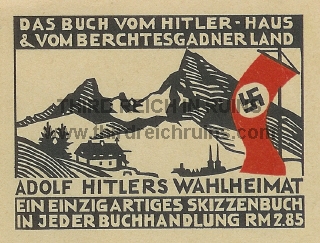
|
|

|

|
| Adolf
Hitler reviews an SA unit in Berchtesgaden in July 1932. The formation was
held in a meadow at the side of Koch-Sternfeld-Straße, near the
Hofbräuhaus, below Nonntal Straße. At Hitler's side is his adjutant
Wilhelm Brückner. At the bottom, an SA member displays the oldest flag
of the Austrian Nazi movment ("Salzburg Erwache!"). (period photos from "Deutschland erwacht -
Werden, Kampf un Sieg der NSDAP," Hamburg, 1933; bottom - from
Heinrich Hoffmann, "Das Braune Heer," Munich, 1932; modern photo above
and
location information courtesy Ralf Hornberger and Florian Beierl) |
|

|

|
|

|
 |
 |
 |
| In this
undated postcard and photo we see the Berchtesgaden Maibaum, or Maypole, festooned
with swastika banners and topped with an eagle and swastika. The Maypole
was located just down from the fountain in the square, at the beginning
of today's pedestrian walking area. (author's collection) |
 |
 |
 |
 |
| This
photo series is from a family's 1936 photo album. They show a fest day
in Berchtesgaden, with many people in the traditional Alpine Trachten
clothing - the women in Dirndls and the men wearing Lederhosen
and traditional leather jackets. (Such clothing can still be seen today
on the Berchtesgaden streets.) The view above is looking down Marktplatz
Straße toward the square, with the spires
of the Stiftskirche church in the background. The photos below were taken in the square, in front
of the Gasthof Neuhaus. (author's collection) |
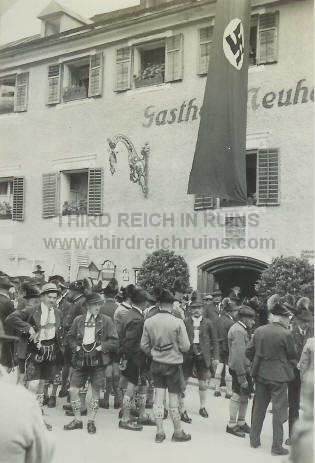 |
 |
 |
 |
Jumping forward in time to May 1945, the
following photos show the American advance and occupation of Berchtesgaden at
the end of World War II.

|

|
As the
Allied forces approached Berchtesgaden on 4 May 1945, Landrat (District
Commissioner) Theodor Jacob was determined to save his Berchtesgadener
Land from senseless fighting. The SS commander on the bombed Obersalzberg
had assured him that he had no intention of defending the area, so Jacob
disbanded the local Volkssturm defenders, and journeyed north out of town.
He ran into the lead elements of an armored column of the 3rd U.S.
Infantry Division at the small settlement of Winkl, near Bischofswiesen.
Jacob discussed surrender with an American officer in the column, who
agreed to his proposals, but insisted that the actual surrender take place
in the town itself (see photo below). This initial meeting is often
reported to have taken place where the railroad tracks cross the road at
Winkl, but it was actually about 1200 meters south of there, at the
workers barracks in Winkl. Key to identifying this spot is the distinctive
Kastenstein hill visible in the middle distance. This spot is today
located on highway B20, near the main Winkl bus stop. The comparison photo
was taken on the 60th anniversary, 4 May 2005. (National Archives, RG
111-SC 204343-S; courtesy Digital
History Archive) |
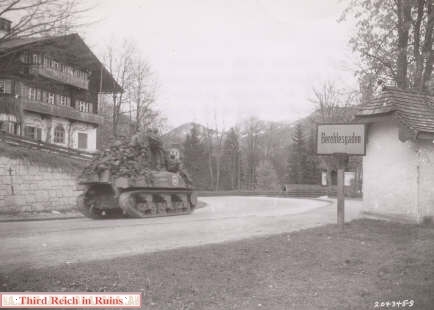
|

|
Elements of the 3rd U.S. Infantry
Division moving into Berchtesgaden on 4 May 1945. The M4 Sherman
tank of the 756th Tank Battalion (attached to the 3rd Infantry Division) was coming
from Bischofswiesen to the north, and had just passed
through the small town of Stanggass. This photo was taken just up the street
from the Berchtesgadener Hof hotel (see below) - the house in the
background is called the Schönhäusl. The comparison view was taken on
the 60th anniversary, 4 May 2005. In 2010 a historic marker was placed
here by veterans of the 3rd Infantry Division (photos below - curiously,
this marker has the photo shown below of local authorities surrendering to
the 3rd Inf. Div. in town, not the photo taken at this location). (National Archives, RG 111-SC
204345-S; courtesy Digital
History Archive)
Note: In 2018 this marker was removed from this location. |
 |
 |
-

|

|
The armored force reaches downtown
Berchtesgaden. These 3rd Infantry Division GIs riding on an M36 tank destroyer
of the 601st Tank Destroyer Battalion are
viewing the Berchtesgaden World War I memorial, painted above the arcades in
the palace square. The memorial
painting by Munich artist Josef Hengge now includes the dates for World War
II (Hengge did the original painting and the post-war restoration). Click here to see photos of the entire painting.
The comparison view was taken on the 60th anniversary, 4:00 PM, 4 May
2005. (National Archives, RG 111-SC 374710; courtesy Digital
History Archive) |

In this previously unpublished photo,
Lt.Col. Kenneth
Wallace, commanding officer of the 1st Battalion, 7th Infantry Regiment, 3rd Infantry Division (on the right),
discusses the surrender of Berchtesgaden with Bürgermeister Karl Sandrock
(left, in overcoat) and Landrat Theodor Jacob (center), in the square in front of the war memorial.
From there, this group traveled up to the Obersalzberg, to complete the
surrender of the area, 4 May 1945 (click here
to see photos of the capture of the Obersalzberg by troops of the 3rd Infantry
Division). (National Archives, RG 111-SC 204346-S; courtesy Digital
History Archive)
Visit the 3rd Infantry Division
webpage, concerning the capture of Berchtesgaden
and the Obersalzberg, for other photos from May 1945.
|

|

|
| Soldiers
from the 506th Parachute Infantry Regiment, 101st Airborne Division,
walk along Maximilian Straße (former Adolf-Hitler-Straße) on 5 May 1945. The building in the
background was marked Villa Graßl, and is today the Café-Bistro
Grassl. (National Archives, RG 111-SC 333021) |
|

|

|
| A
motorized column from the 101st Airborne Division drives up
Bahnhofstraße into the main part of town. Berchtesgaden's trademark
mountain, the Watzmann, towers in the background. The comparison photo
was taken during the 70th anniversary in May 2015. (National Archives, RG 111-SC) |
-

|

|
GIs at the Berchtesgaden
Postamt
(post office) in May 1945 - a still from color movie film by George Stevens.
The only post-war change to the mosaic has
been the removal of the swastika from the flag. (Although not affecting the
mosaic, this Postamt building was converted to a Burger King
restaurant in 2013.) (Max
Hastings and George Stevens, "Victory in Europe," Boston, Little, Brown &
Co., 1985) |
 |
 |
|
The Postamt mosaic was by the Munich firm
of F.X. Zettler. The photo above is from a 1938 architectural
exhibition. The photos below show GIs visiting the Postamt in 1945
(in the photo on the right, from a 45th Infantry Division collection,
the swastika in the mosaic had
already been removed). (above left -
Exhibition Catalog of the 2. Deutsche
Architektur-und-Kunsthandwerkausstellung, Munich, 1938; below left -
U.S. National Archives, RG242FH-A49866; below right - courtesy Frank
Tompkins) |
 |
 |

|

|
Two
soldiers of the 101st Airborne Division toast the end of World War II and
the Allied victory in the Berchtesgaden Schlossplatz, beneath the World
War I memorial. In the original version, the fallen soldiers were called
Heroes (Helden), which was changed to Sons (Söhnen) after the war. (U.S.
National Archives, RG 111-SC) |
-

|

|
The Berchtesgaden
Bahnhof
(train station) was
built from 1937-1940. Designed in massive Third Reich style
(to impress visitors), the building had a special reception area reserved for Hitler and his
guests (seen on
the right above - around the corner from the circular tower in the left-hand
photo). Note - The Bahnhof was bought by a private purchaser in
2015, and the building has been remodeled, with bowling alleys and meeting
rooms added, and a "Bavarian Pub" in Hitler's former reception
area. |

|

|
Hitler
used the doorway on the left to travel to and from his special train, into
his personal reception area of the Bahnhof. The main public area is seen on
the right, complete with massive columns, high windows, and
Berchtesgaden-themed murals (these were painted in the 1950s, but they may
have replaced similar Third Reich era works). Recent remodeling revealed
where metal letters had originally been mounted as signs for "Zeitungen"
(newspapers) and "Andenken" (souvenirs). Other such signs were
for "Handgepäck" (hand luggage to check), "Gepäck
Expreßgut" (shipped baggage), "Zigarren" (cigars), "Feinkost" (food, snacks). The sign for "Zu
den Zügen" (to the trains) still remains above the rear exit. |
 |
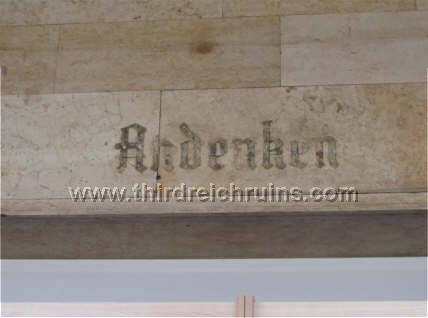 |
-
 |
 |
 |
| A few reminders of the Third Reich past can still be seen on the
Bahnhof - on the left is the insignia of the Deutsche Reichsbahn above a
doorway. In the center can still be seen the Hoheitszeichen
wreath, and a faint outline where the Reichs Eagle used to be, over one of the
Post Office doorways (building at the left of the main Bahnhof building,
now a Burger King restaurant).
On the right is the construction start date of 1937 above a stairway
leading to a bridge over the tracks behind the station, for pedestrian
crossing into the town. (Click here to see an air-raid
tunnel shelter built for Bahnhof and Postamt employees.) |

The Hauptbahnhof as my father saw it in
1946.
(photo by Lt. Delbert R. Walden; collection of G.A. and G.R. Walden)
 |
 |
| The Duke
and Duchess of Windsor (ex- King Edward VIII and his wife the former
Wallis Simpson) visited Adolf Hitler at the Berghof on 22 October 1937.
Here, they are seen in front of the Berchtesgaden Hauptbahnhof, on their way home.
At the left is Robert Ley, head of the German Labor Front, with Hitler's
interpreter Paul Schmidt in the center. The large building in the background of
both views is the Kurdirektion (Tourist Info Center). |
-
|

|

 |
|
This
railroad tunnel was built just east of the Bahnhof, for a planned rail
line between Berchtesgaden and Salzburg. This line was never completed,
but the tunnel was used at the end of the war to hide one of Hermann
Göring's personal trains, filled with his art collection. The tunnel
side is dated 1940, and once presumably bore an eagle and swastika. (right
- courtesy Ralf Hornberger)
Göring's art collection was
stored in several places - in this and another nearby train, in the
tunnels beneath his house on the Obersalzberg, and in a tunnel beneath
the Luftwaffe headquarters in Berchtesgaden. |
|

|

|
| As the
U.S. Army occupiers rounded up Göring's collection, it was stored and
displayed in a building in the Unterstein area of nearby Schönau. This
building was part of a vacation complex for German rail workers, and had
been taken over by the Luftwaffe in 1944 as a rest center. The 101st
Airborne Division displayed Göring's art collection here in 1945. Today
this is the Hotel Hubertus, again used by the Bundesbahn as an employee
relaxation center. ("The Epic of the 101st Airborne," 101st Airborne
Division Public Relations Office, Auxerre, France, 1945) |
-

|

|
As visitors left Berchtesgaden for
the Obersalzberg, the exterior security zone began immediately at the Berchtesgadener Ache
river. At the Schießstättbrücke bridge was the first guard house. This building is rarely recognized
today as part of the Obersalzberg complex, or even as a Third Reich building at all, but
the changes from that time have been minimal. During the Third Reich period,
two columns at the end of the bridge supported a sign reading
"Führer, wir danken Dir" (Führer, we thank you). (above
- Frank,
"Hitler, Göring"; below - airborneyellow archives)
Click here to see more photos of this gate
house. |
 |
 |

This photo shows the 1937 date
carved in the wood above the doorway.
-

|

|
The Berchtesgadener
Hof hotel had previously been the
"Grand Hotel Auguste Victoria," popular with visiting royalty. The
Nazis bought it in 1936, remodeled it and renamed it the Berchtesgadener Hof, and used it to house
dignitaries visiting
Hitler's Berghof, such as the Duke and Duchess of Windsor, British Prime Minister Neville
Chamberlain, and David Lloyd George. High-ranking Nazis such as Josef Goebbels, Heinrich
Himmler, and Joachim von Ribbentrop also stayed here, as did visiting military officers
such as Erwin Rommel. Eva Braun lived at the Berchtesgadener Hof when she first came to
Berchtesgaden, before moving into the Berghof. Later, Obersalzberg functionaries such as
Bormann's brother Albert lived here, as did Hitler's sister Paula (incognito, as Paula
Wolf). After the U.S. Army occupied the area in May 1945, the Berchtesgadener Hof was the
scene of several high-ranking surrenders, including that of Field Marshal
Albert Kesselring.
The U.S. Army took over the Berchtesgadener Hof in
1945, and it was one of the show-pieces of the Armed Forces Recreation Center until 1995
(my father stayed here in 1946). The rear balconies and sun terrace were justly famed for
their view of the mountains. Sadly, when the U.S. Army left in late 1995, the famed hotel
was closed and locked, as it remained for several years until it was torn
down in 2006, to make way for a new "Haus der Berge" museum of the
mountains. (period
illustration from a wartime pamphlet on the hotel, brought home by my father in
1946 - note the Nazi flag hanging over the hotel entrance)
Click here
to visit a subpage with several more photos of the Berchtesgadener
Hof, including the 2006 destruction. |
-
|
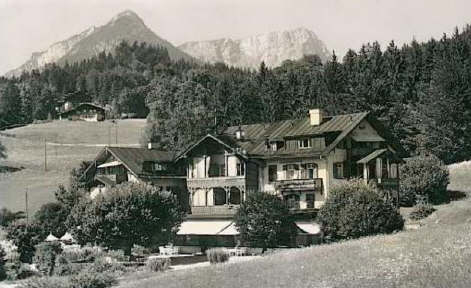
|
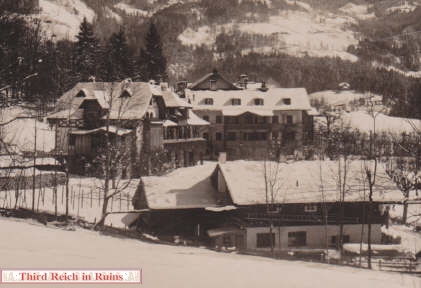
|
| Left - a
1936 postcard view of the Hotel Geiger; right - a winter scene from a
1938 dated postcard. (left - courtesy Harry von Gebhardt; right
- author's collection) |
|

|

|
| As a
Luftwaffe military facility, the Hotel Geiger had a tunnel system for
air attack protection built into the hillside behind it. In 1988 the
tunnels were filled in and the entrances were blocked. |
-

|

|
Paula was Adolf
Hitler's only full sibling who lived to adulthood. During much of the Third Reich period
she lived incognito by her brother's desire, as Paula Wolf. After the war she lived
quietly in Berchtesgaden, where she died in 1960 and was buried in the Bergfriedhof
cemetery. Also to be found in the Bergfriedhof cemetery are cenotaphs to
Fritz Todt, Nazi Armaments Minister, and Gen. Rudolf Schmundt, Hitler's
Army Adjutant. Early Nazi publicist Dietrich
Eckart and Kanzlei chief
Hans Lammers are buried in the Altfriedhof cemetery in downtown
Berchtesgaden. Note - Paula Hitler's grave plot is also used by another
family, and when other burials are made in the plot, her grave marker may
be temporarily removed or covered over. |
|

|
As of October 2007, Paula Hitler's name on her
marker has been covered over by a plaque bearing the names of the couple
who owned this plot and were buried there in 2005 and 2006.
According to local
information, Paula Hitler is still buried there even though her name is
not visible on the grave marker.
|
Click here
to see some air-raid shelter tunnels and bunkers in Berchtesgaden.
 Continue to the Obersalzberg Continue to the Obersalzberg
 View other Berchtesgaden area Third Reich buildings and sites View other Berchtesgaden area Third Reich buildings and sites
 Visit the Berchtesgadener
Hof hotel, then and now
Visit the Berchtesgadener
Hof hotel, then and now
 Visit
Berchtesgaden area anti-aircraft (Flak) positions
Visit
Berchtesgaden area anti-aircraft (Flak) positions
 Click here to visit
a page about the capture of German Gen. Tolsdorf by the 101st Airborne Div.,
near Hirschbichl, Austria.
Click here to visit
a page about the capture of German Gen. Tolsdorf by the 101st Airborne Div.,
near Hirschbichl, Austria.
Click here
to visit a page with large-scale photos and panoramic views of sites in
Berchtesgaden and the Obersalzberg.
For further information, including Internet links, check
the Bibliography page.
I wish to express my sincere appreciation here to the
following individuals, who have supplied significant information and/or photographs for
use on my Berchtesgaden/Obersalzberg pages: Florian Beierl, Mark Eve, John
Figgins,
George Foehringer, Ralf Hornberger, Randall Lee Rose, Frau Ingrid Scharfenberg,
Jacqueline Wilson.
 |
My guide
book to Third Reich sites in the Berchtesgaden and Obersalzberg area has
been published by Fonthill Media.
"Hitler's
Berchtesgaden" is available at Amazon and other retailers ( the
Kindle version is also available from Amazon). |
Guided Tours
For personal guided tours in
English of Third Reich sites in Berchtesgaden and on the Obersalzberg (and other
local sites) from a certified and accredited local tour guide, contact:
Tom Lewis
+49-(0)1602-641-800
atobersalzberg@sky.com

BEGAFILM
- Historic Films About Berechtesgaden and the Obersalzberg

|
